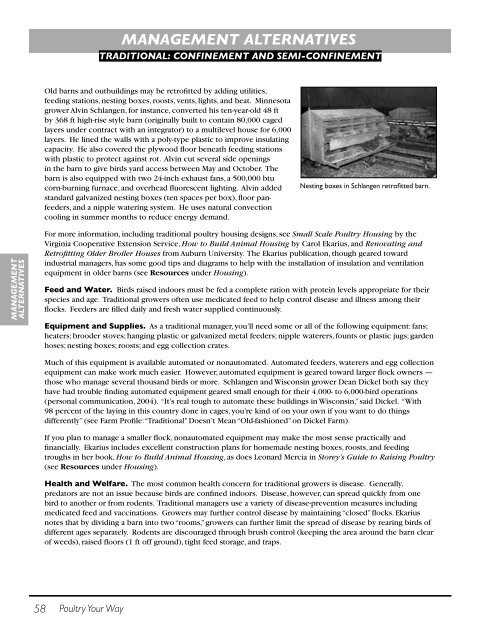Poultry Your Way - Center for Integrated Agricultural Systems ...
Poultry Your Way - Center for Integrated Agricultural Systems ...
Poultry Your Way - Center for Integrated Agricultural Systems ...
You also want an ePaper? Increase the reach of your titles
YUMPU automatically turns print PDFs into web optimized ePapers that Google loves.
MANAGEMENT<br />
ALTERNATIVES<br />
58<br />
<strong>Poultry</strong> <strong>Your</strong> <strong>Way</strong><br />
MANAGEMENT ALTERNATIVES<br />
TRADITIONAL: CONFINEMENT AND SEMI-CONFINEMENT<br />
Old barns and outbuildings may be retrofitted by adding utilities,<br />
feeding stations, nesting boxes, roosts, vents, lights, and heat. Minnesota<br />
grower Alvin Schlangen, <strong>for</strong> instance, converted his ten-year-old 48 ft<br />
by 368 ft high-rise style barn (originally built to contain 80,000 caged<br />
layers under contract with an integrator) to a multilevel house <strong>for</strong> 6,000<br />
layers. He lined the walls with a poly-type plastic to improve insulating<br />
capacity. He also covered the plywood floor beneath feeding stations<br />
with plastic to protect against rot. Alvin cut several side openings<br />
in the barn to give birds yard access between May and October. The<br />
barn is also equipped with two 24-inch exhaust fans, a 500,000 btu<br />
corn-burning furnace, and overhead fluorescent lighting. Alvin added<br />
standard galvanized nesting boxes (ten spaces per box), floor panfeeders,<br />
and a nipple watering system. He uses natural convection<br />
cooling in summer months to reduce energy demand.<br />
Nesting boxes in Schlangen retrofitted barn.<br />
For more in<strong>for</strong>mation, including traditional poultry housing designs, see Small Scale <strong>Poultry</strong> Housing by the<br />
Virginia Cooperative Extension Service, How to Build Animal Housing by Carol Ekarius, and Renovating and<br />
Retrofitting Older Broiler Houses from Auburn University. The Ekarius publication, though geared toward<br />
industrial managers, has some good tips and diagrams to help with the installation of insulation and ventilation<br />
equipment in older barns (see Resources under Housing).<br />
Feed and Water. Birds raised indoors must be fed a complete ration with protein levels appropriate <strong>for</strong> their<br />
species and age. Traditional growers often use medicated feed to help control disease and illness among their<br />
flocks. Feeders are filled daily and fresh water supplied continuously.<br />
Equipment and Supplies. As a traditional manager, you’ll need some or all of the following equipment: fans;<br />
heaters; brooder stoves; hanging plastic or galvanized metal feeders; nipple waterers, founts or plastic jugs; garden<br />
hoses; nesting boxes; roosts; and egg collection crates.<br />
Much of this equipment is available automated or nonautomated. Automated feeders, waterers and egg collection<br />
equipment can make work much easier. However, automated equipment is geared toward larger flock owners —<br />
those who manage several thousand birds or more. Schlangen and Wisconsin grower Dean Dickel both say they<br />
have had trouble finding automated equipment geared small enough <strong>for</strong> their 4,000- to 6,000-bird operations<br />
(personal communication, 2004). “It’s real tough to automate these buildings in Wisconsin,” said Dickel. “With<br />
98 percent of the laying in this country done in cages, you’re kind of on your own if you want to do things<br />
differently” (see Farm Profile: “Traditional” Doesn’t Mean “Old-fashioned” on Dickel Farm).<br />
If you plan to manage a smaller flock, nonautomated equipment may make the most sense practically and<br />
financially. Ekarius includes excellent construction plans <strong>for</strong> homemade nesting boxes, roosts, and feeding<br />
troughs in her book, How to Build Animal Housing, as does Leonard Mercia in Storey’s Guide to Raising <strong>Poultry</strong><br />
(see Resources under Housing).<br />
Health and Welfare. The most common health concern <strong>for</strong> traditional growers is disease. Generally,<br />
predators are not an issue because birds are confined indoors. Disease, however, can spread quickly from one<br />
bird to another or from rodents. Traditional managers use a variety of disease-prevention measures including<br />
medicated feed and vaccinations. Growers may further control disease by maintaining “closed” flocks. Ekarius<br />
notes that by dividing a barn into two “rooms,” growers can further limit the spread of disease by rearing birds of<br />
different ages separately. Rodents are discouraged through brush control (keeping the area around the barn clear<br />
of weeds), raised floors (1 ft off ground), tight feed storage, and traps.

















